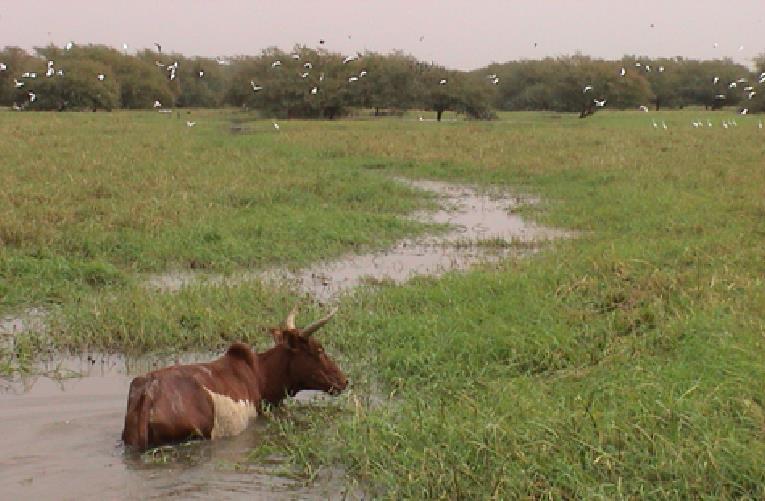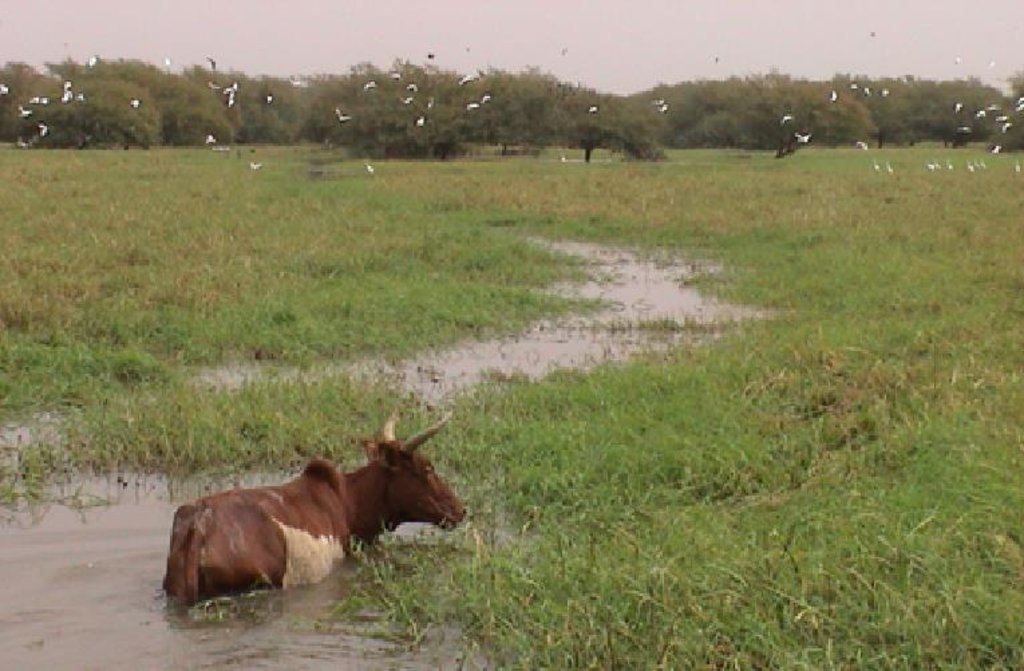Promoting bourgou growing [马里]
- 创建:
- 更新:
- 编制者: Dieter Nill
- 编辑者: –
- 审查者: Deborah Niggli, Alexandra Gavilano
Promotion de la bourgou-culture (French)
technologies_1637 - 马里
查看章节
全部展开 全部收起1. 一般信息
1.2 参与该技术评估和文件编制的资源人员和机构的联系方式
SLM专业人员:
Coulibaly Bakary Sékou
International Fund for Agricultural Development (IFAD)
马里
SLM专业人员:
Nadio Mamadou
National Coordinator for IFAD Programmes in Mali (CNPPF)
马里
有助于对技术进行记录/评估的项目名称(如相关)
Manual of Good Practices in Small Scale Irrigation in the Sahel (GIZ )有助于对技术进行记录/评估的机构名称(如相关)
Deutsche Gesellschaft für Internationale Zusammenarbeit (GIZ) GmbH (GIZ) - 德国1.3 关于使用通过WOCAT记录的数据的条件
编制者和关键资源人员接受有关使用通过WOCAT记录数据的条件。:
是
1.4 所述技术的可持续性声明
这里所描述的技术在土地退化方面是否存在问题,导致无法被认为是一种可持续的土地管理技术?:
否
2. SLM技术的说明
2.1 技术简介
技术定义:
Replanting and cultivating bourgou improves the availability of forage for livestock
2.2 技术的详细说明
说明:
Bourgou (Echinochloa stagnina) is an essential food for livestock in the Niger River’s inland delta region. Given the lack of forage and pastureland for livestock, farmers have taken to replanting and cultivating bourgou in order to improve the availability of forage for animals.
This activity focuses on several objectives, namely: increasing forage production by regenerating bourgou; restoring the environment and biodiversity around lakes and ponds; improving the diet and reproduction of local livestock; producing plant extracts for beverage making; increasing producers’ incomes; extending bourgou growing into the Niger River’s inland delta.
Bourgou pastures can produce up to 3,101 tonnes of dry matter per hectare in the first year. The pastures can support between 782 and 885 tropical livestock units from the March to June period. Fauna and flora (biodiversity) reappear. A cow feeding on green bourgou gives milk all year round and a cow that has spent a season in a bourgou pasture produces one calf per year. Steamed and macerated bourgou stalks produce a highly prized sweet juice. Bourgou seed is
incorporated into human diets. Bourgou helps to increase incomes.
The regeneration activities are carried out under the supervision of the Korientzé forestry officer and the local SADeF facilitator. Regeneration is possible from the month of January and can be carried out as soon as the waters recede. The regeneration techniques used are the layering and transplanting of bourgou cuttings or divisions.
The access of animals to growing sites is regulated and reserved for working oxen, calves, dairy cattle, sheep, goats, donkeys and horses. Cow, horse and donkey access costs 500 CFA francs per head, while other animals are charged at 250 CFA francs per head. A 15% share of the earnings is paid to the Korombana commune authority for the benefit of the community. The remaining funds are allocated to areas that contribute to developing the cooperative’s activities.
The commune authority plays an institutional support role, making officers available to the cooperative. Furthermore, it oversees the correct application of the local agreement on managing bourgou pastures. The Deputy Prefect, through the commune authority, makes security officers and technical service officers available to the cooperative. A rotation system is adopted for farming plots.
The project team provides funding and training. The cooperative implements the regulations and participates in works, management and farming.
The main beneficiaries are the 200 members of the organisation and other livestock farmers from the villages of Korientzé, Bagui and Kéra. An area totalling 310 hectares has been regenerated.
Regenerating bourgou by directly sowing seed goes back to the 1970s. However, regeneration using cuttings began in 1984 with the development of a demonstration plot. From 1999, the Near East Foundation (NEF) became interested in the activity, going on to provide financial support for the Korombana livestock farmers’ cooperative.
2.3 技术照片
2.5 已应用该技术的、本评估所涵盖的国家/地区/地点
国家:
马里
区域/州/省:
Mali
有关地点的进一步说明:
Gouloumbo, Korientzé, Kéra, Mousocouraré, M’Bessana, Tiécouraré, Sangui
具体说明该技术的分布:
- 均匀地分布在一个区域
如果技术均匀分布在一个区域,则指定覆盖的区域(单位为平方千米):
3.1
注释:
Total area covered by the SLM Technology is 3.1 km2.
Sites are located to the north of Gouloumbo village, to the south of Korientzé and Kéra villages, to the east of the three Diamadoua villages (Mousocouraré, M’Bessana and Tiécouraré) and to the west of Sangui.
The main beneficiaries are the 200 members of the organisation and other livestock farmers. A total area of 310 hectares has been regenerated
2.6 实施日期
如果不知道确切的年份,请说明大概的日期:
- 10-50年前
2.7 技术介绍
详细说明该技术是如何引入的:
- 通过项目/外部干预
注释(项目类型等):
Regenerating bourgou by directly sowing seed goes back to the 1970s. However, regeneration using cuttings began in 1984 with the development of a demonstration plot. From 1999, the Near East Foundation (NEF) became interested in the activity, going on to provide financial
support for the Korombana livestock farmers’ cooperative to regenerate seven hectares.
3. SLM技术的分类
3.1 该技术的主要目的
- 改良生产
3.2 应用该技术的当前土地利用类型
同一土地单元内混合使用的土地::
是
具体说明混合土地使用(作物/放牧/树木):
- 农牧业(包括农牧结合)

农田
每年的生长季节数:
- 1
具体说明:
Longest growing period in days: 120; Longest growing period from month to month: August-November

牧场
集约放牧/饲料生产:
- 改良牧场
注释:
Major land use problems (compiler’s opinion): lack of forage and pastureland for livestock
Livestock density: 1-10 LU /km2
3.4 供水
该技术所应用土地的供水:
- 混合雨水灌溉
3.5 该技术所属的SLM组
- 畜牧业和牧场管理
3.6 包含该技术的可持续土地管理措施

植物措施
- V2:草和多年生草本植物
注释:
Type of vegetative measures: scattered / dispersed
3.7 该技术强调的主要土地退化类型

生物性退化
- Bc:植被覆盖的减少
- Bq:数量/生物量减少
注释:
Main causes of degradation: overgrazing, population pressure
3.8 防止、减少或恢复土地退化
具体数量名该技术与土地退化有关的目标:
- 修复/恢复严重退化的土地
4. 技术规范、实施活动、投入和成本
4.1 该技术的技术图纸
技术规范(与技术图纸相关):
Technical knowledge required for field staff / advisors: moderate
Technical knowledge required for land users: low
Main technical functions: increase of biomass (quantity), promotion of vegetation species and varieties (quality, eg palatable fodder)
Scattered / dispersed
Vegetative material: G : grass
Grass species: bourgou
4.2 有关投入和成本计算的一般信息
其它/国家货币(具体说明):
CFA Franc
如相关,注明美元与当地货币的汇率(例如1美元=79.9巴西雷亚尔):1美元=:
517.0
4.3 技术建立活动
| 活动 | 时间(季度) | |
|---|---|---|
| 1. | layering and transplanting of bourgou cuttings or divisions |
4.4 技术建立所需要的费用和投入
| 对投入进行具体说明 | 单位 | 数量 | 单位成本 | 每项投入的总成本 | 土地使用者承担的成本% | |
|---|---|---|---|---|---|---|
| 其它 | Total construction | ha | 1.0 | 138.0 | 138.0 | 100.0 |
| 技术建立所需总成本 | 138.0 | |||||
| 技术建立总成本,美元 | 0.27 | |||||
4.7 影响成本的最重要因素
描述影响成本的最决定性因素:
The total investment cost for 310 hectares is 22,144,465 CFA francs (42'891 Dollar), which equates to 71,400 CFA francs per hectares (138 Dollar). The fees charged during the first season of bourgou pasture farming in June 2009 brought in 3,142,500 CFA francs. The price of a bale of bourgou ranges from 50 to 250 CFA francs depending on the time of year. The second season (April 2010) brought in 2,241,000 CFA francs. Some 687 kilograms of bourgou seed were collected, which served to provision other localities.
5. 自然和人文环境
5.1 气候
年降雨量
- < 250毫米
- 251-500毫米
- 501-750毫米
- 751-1,000毫米
- 1,001-1,500毫米
- 1,501-2,000毫米
- 2,001-3,000毫米
- 3,001-4,000毫米
- > 4,000毫米
农业气候带
- 半干旱
Thermal climate class: tropics
5.2 地形
平均坡度:
- 水平(0-2%)
- 缓降(3-5%)
- 平缓(6-10%)
- 滚坡(11-15%)
- 崎岖(16-30%)
- 陡峭(31-60%)
- 非常陡峭(>60%)
地形:
- 高原/平原
- 山脊
- 山坡
- 山地斜坡
- 麓坡
- 谷底
垂直分布带:
- 0-100 m a.s.l.
- 101-500 m a.s.l.
- 501-1,000 m a.s.l.
- 1,001-1,500 m a.s.l.
- 1,501-2,000 m a.s.l.
- 2,001-2,500 m a.s.l.
- 2,501-3,000 m a.s.l.
- 3,001-4,000 m a.s.l.
- > 4,000 m a.s.l.
5.3 土壤
平均土层深度:
- 非常浅(0-20厘米)
- 浅(21-50厘米)
- 中等深度(51-80厘米)
- 深(81-120厘米)
- 非常深(> 120厘米)
土壤质地(表土):
- 中粒(壤土、粉土)
- 细粒/重质(粘土)
表土有机质:
- 中(1-3%)
- 低(<1%)
5.4 水资源可用性和质量
地下水位表:
5-50米
地表水的可用性:
中等
水质(未处理):
仅供农业使用(灌溉)
5.5 生物多样性
物种多样性:
- 中等
5.6 应用该技术的土地使用者的特征
非农收入:
- 收入的10-50%
相对财富水平:
- 贫瘠
- 平均水平
机械化水平:
- 手工作业
性别:
- 男人
说明土地使用者的其他有关特征:
Population density: < 10 persons/km2
Annual population growth: 2% - 3%
10% of the land users are rich.
50% of the land users are average wealthy.
30% of the land users are poor.
10% of the land users are very poor.
5.7 应用该技术的土地使用者使用的平均土地面积
- < 0.5 公顷
- 0.5-1 公顷
- 1-2 公顷
- 2-5公顷
- 5-15公顷
- 15-50公顷
- 50-100公顷
- 100-500公顷
- 500-1,000公顷
- 1,000-10,000公顷
- > 10,000公顷
这被认为是小规模、中规模还是大规模的(参照当地实际情况)?:
- 小规模的
5.8 土地所有权、土地使用权和水使用权
注释:
The irrigated land is allocated by the chief
5.9 进入服务和基础设施的通道
健康:
- 贫瘠
- 适度的
- 好
教育:
- 贫瘠
- 适度的
- 好
技术援助:
- 贫瘠
- 适度的
- 好
就业(例如非农):
- 贫瘠
- 适度的
- 好
市场:
- 贫瘠
- 适度的
- 好
能源:
- 贫瘠
- 适度的
- 好
道路和交通:
- 贫瘠
- 适度的
- 好
饮用水和卫生设施:
- 贫瘠
- 适度的
- 好
金融服务:
- 贫瘠
- 适度的
- 好
6. 影响和结论性说明
6.1 该技术的现场影响
社会经济效应
生产
饲料生产
饲料质量
畜牧生产
产品多样性
生产区域
收入和成本
农业收入
收入来源的多样性
社会文化影响
食品安全/自给自足
冲突缓解
Contribution to human well-being
注释/具体说明:
Bourgou pastures can produce up to 3,101 tonnes of dry matter per hectare in the first year. A cow feeding on green bourgou gives milk all year round and a cow that has spent a season in a bourgou pasture produces one calf per year. Bourgou seed is incorporated into human diets. Bourgou helps to increase incomes.
生态影响
土壤
土壤水分
土壤覆盖层
土壤流失
土壤有机物/地下C
生物多样性:植被、动物
生物量/地上C
植物多样性
减少气候和灾害风险
风速
6.2 该技术的场外影响已经显现
下游淤积
风力搬运沉积物
6.3 技术对渐变气候以及与气候相关的极端情况/灾害的暴露和敏感性(土地使用者认为的极端情况/灾害)
渐变气候
渐变气候
| 季节 | 增加或减少 | 该技术是如何应对的? | |
|---|---|---|---|
| 年温度 | 增加 | 好 |
气候有关的极端情况(灾害)
气象灾害
| 该技术是如何应对的? | |
|---|---|
| 局地暴雨 | 好 |
| 局地风暴 | 好 |
气候灾害
| 该技术是如何应对的? | |
|---|---|
| 干旱 | 好 |
水文灾害
| 该技术是如何应对的? | |
|---|---|
| 比较和缓的(河道)洪水 | 好 |
其他气候相关的后果
其他气候相关的后果
| 该技术是如何应对的? | |
|---|---|
| 缩短生长期 | 好 |
6.4 成本效益分析
技术收益与技术建立成本相比如何(从土地使用者的角度看)?
短期回报:
非常积极
长期回报:
非常积极
技术收益与技术维护成本/经常性成本相比如何(从土地使用者的角度看)?
短期回报:
非常积极
长期回报:
非常积极
6.5 技术采用
注释:
There is a moderate trend towards spontaneous adoption of the Technology
The Korombana livestock farmers’ cooperative is now passing on its experience to others in the West African sub-region and, in so doing, is promoting its replication.
6.7 该技术的优点/长处/机会
| 编制者或其他关键资源人员认为的长处/优势/机会 |
|---|
| Increased fodder production. Bourgou pastures can produce up to 3,101 tonnes of dry matter per hectare in the first year. A cow feeding on green bourgou gives milk all year round and a cow that has spent a season in a bourgou pasture produces one calf per year. |
| Bourgou helps to increase incomes. |
| Bourgou seed is incorporated into human diets. Steamed and macerated bourgou stalks produce a highly prized sweet juice. |
6.8 技术的弱点/缺点/风险及其克服方法
| 编制者或其他关键资源人员认为的弱点/缺点/风险 | 如何克服它们? |
|---|---|
| Organisationally, there are several weaknesses: failure to respect meeting times and poor attendance; noticeable confusion between the roles of the management board and the monitoring commission when carrying out the practice; the lack of strategies for coping with lean periods, such as fodder storage; insufficient knowledge among the parties to Mali’s 'Pastoral Charter’. |
7. 参考和链接
7.1 信息的方法/来源
- 实地考察、实地调查
- 与土地使用者的访谈
(现场)数据是什么时候汇编的?:
01/07/2012
7.2 参考可用出版物
标题、作者、年份、ISBN:
Manual of Good Practices in Small Scale Irrigation in the Sahel. Experiences from Mali. Published by GIZ in 2014.
可以从哪里获得?成本如何?
http://star-www.giz.de/starweb/giz/pub/servlet.starweb
标题、作者、年份、ISBN:
SADeF (n.d.): Les bourgoutières régénérées par la cooperative des éleveurs de Korombana [The bourgou pastures regenerated by the Korombana livestock farmers’ cooperative]
链接和模块
全部展开 全部收起链接
无链接
模块
无模块



